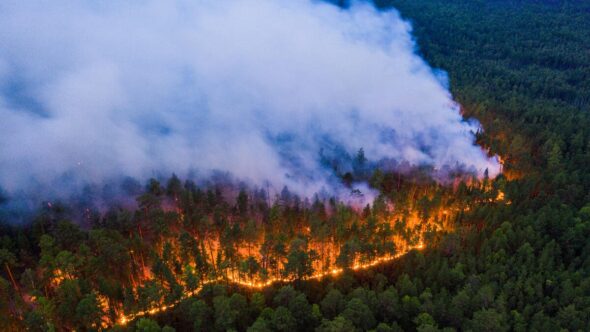It is estimated that less than 10 percent of the fires in Russia is actually put out. The rest is allowed to burn, which damages millions of hectares of forests and frees into the atmosphere hundreds of millions of tons of carbon dioxide and other gases. What is the cost of the Siberian fires? – Mariusz Marszałkowski, editor at BiznesAlert.pl, asks.
Due to its size, Russia is one of the most exposed countries on Earth when it comes to the impact of climate change. On the one hand, destructive floods are ravaging the Kuban region in the West and the areas along the Angara in the Far East. On the other, never before seen draughts are devastating Crimea, and widespread fires raze huge swathes of Siberia.
For year now, Russia’s representatives, including Vladimir Putin, have been mocking the West’s efforts to reduce the emission of GHGs into the atmosphere, but at the same time they want to reap huge profits from selling high-emission hydrocarbons such as gas, oil and coal.
However, the violent climatic events are becoming increasingly burdensome for Russia. Already in early January this year firefighters had to face fires near Sochi. In April the fires ravaged Bashkortostan, Khakassia and the Moscow region. Still, the biggest challenges emerged in early June in the Irkutsk oblast and the Republic of Sakha. The fire season in Siberia regularly starts in June.
An awful year in Siberia
2021 is an exceptionally difficult year when it comes to fires. According to the data from the forest fires monitoring and measurement system provided by the Russian agency Rosleschoz on the 11th of August, since the beginning of 2021 there have been over 20 thousand fires in Russia. They engulfed 16,143 million hectares. During the same time in 2020, the fires consumed 13.5 million hectares, whereas in the entire 2020, 16.5 million hectares burned down. This is almost as much as in the beginning of August this year. Only in Sakha since the beginning of the year 8.94 million hectares were engulfed in flames. It is a million more than a year ago.
When it comes to fires, 2012 was a record-breaking year in Russia. During that year the fires consumed 18 million hectares of forests, setting the record of the century. It is very concerning that by August 10 of that year, almost 17 million hectares of forest had burned. This means the current year may be one of the most tragic, when it comes to the amount of damage done by the fires consuming Russian forests. In 2019 the fires burned 15 million hectares, and in 2018, 15.4 million hectares.
In order to understand the scale of the tragedy, one needs to understand that this year’s fires have already consumed an area equal to the combined size of Lithuania, Latvia and Estonia, and the season isn’t even over yet.
The fires in Siberia and elsewhere cost a lot
These fires are significantly larger in scale that this year’s fires in Turkey and Greece, and they have a huge impact on the environment. There are a few reasons behind this.
The first is the emission of the harmful GHGs, such as carbon dioxide or nitrogen dioxide. The gases don’t primarily come from the burning trees, but from the peat mulch. It is the main culprit behind the release of harmful gases during the Siberian fires.
According to the European Copernicus Land Monitoring Service, between the beginning of June and mid August even 800 million tons of CO2 was released into the atmosphere in result of the Siberian fires. It’s twice as much as the amount that was released during last year’s fires there. 800 million tons is a figure that exceeds the yearly level of emissions produced by Europe’s biggest polluter – Germany. In 2020 Poland released into the atmosphere 370 million tons of CO2.
According to scientists from the Krasnoyarsk Science Center of the Siberian Branch of the Russian Academy of Sciences, this figure is inflated, and the real one is between 100 and 300 million tons a year, depending on the intensity of the fires, not their area. Russia’s Roleschoz has provided data according to which in 2019 GHG emissions caused by fire forests amounted to 284 million tons.
Another environmental issue is caused by the airborne smoke. The toxic cloud visible on satellite imagery stretches along 6500 km, and has already reached the North Pole and the shores of Alaska. Because of this, the affected Russian cities in the Far East, e.g. Ulan-Ude, Irkutsk and Yakutsk, had to introduce special restrictions on, among others, working outside, air traffic, which was either shut down or limited, and travel by inland navigation. Due to the thick smoke, the air forces engaged in putting the fires out had to be grounded as well.
The fires in Siberia are also a long-term problem. According to data from 2017 compiled for the UN, Russian forests absorb 800 million tons of carbon dioxide a year. So, this means that only this year’s fires will neutralize the positive environmental impact that the Russian forests have so far provided. This is a serious setback to the world’s efforts, with the EU leading the way, to limit the anthropogenic emission of greenhouse gases as much as possible.
Why Russia doesn’t put out the fires in Siberia?
The fires in Russia are also a huge challenge for the Russian budget, and cause substantial economic losses. Some of those are difficult to calculate, e.g. stopping air and marine traffic, limiting human activities due to smoke, or even losing timber in the fires. Rosleschoz has estimated that the economic losses caused by the fires in Siberia in 2019 reached RUB 14.5 billion (USD 200 million).
Additionally, this year the federal reserve needed shell out for the firefighting efforts another RUB 14.5 bn. It is worth stressing that this money comes from the state budget only. The federal entities also have their own budgets for fighting fires, but their size is difficult to estimate. Other entities also have means to fight the fire, those include Rosleschoz, Avialesochrana (an air unit responsible for monitoring and firefighting), the Ministry of Emergency Situations (MCzS), the Defense Ministry and others.
According to the conservative calculations prepared by MCzS in 2019, in case of one of the fires that engulfed 836 hectares, it has been calculated that the cost of extinguishing one hectare would be RUB 166 thousand (USD 2.24 thousand), and the losses caused by the fire of one hectare amounted to RUS 5.5 thousand (USD 74).
This is where we stumble upon the most difficult element – the firefighting itself. Greenpeace claims that each year Russia puts out only a little under 10 percent of the fires. The rest is allowed to burn until the fire dies down on its own. This is because of the long distances, bad infrastructure or lack thereof, and the topography of the impacted forests in the far Siberia.
On the basis of regulations from 2015, the local governments can abandon firefighting if the fire is in an are that is „unavailable”. Usually areas further away than 5 km from an inhabited area fall into that category. The firefighters that are still on high demand are focusing only on fighting the element that directly threatens the residents or infrastructure.
Sometimes, the anger of the local communities forces the authorities to pretend they are fighting against the fires by sending additional air support to help extinguish the fires. This isn’t always an efficient strategy, but it is very costly.
According to the Russian portal Znak, an hour of flight of the Mi-8 helicopter costs RUB 140 thousand (USD 19 thousand). The cost of a one hour flight of the Il-76 or the Be-200 amphibious aircraft is between RUB 200 and 400 thousand (USD 25- 54 thousand). This way of extinguishing fires is inefficient, because the Il-76 can take the water for a drop only at airports that are adjusted to do this, while the load itself tops at 24 tons. A plane needs to often fly a few hundred kilometers to return to base. The Il-76 can make up to two water drops a day. The Be-200 amphibious aircraft is more efficient, as it can scoop water even from rivers, but its capacity is only 12 tons, which is half as much as of the Il-76.
However, Russians did find a way to use their aerial firefighting capabilities. Instead of wasting their potential on putting out fires in Siberia, they rent it out abroad on a mass scale and for money. During this year’s fires in Turkey and Greece, Russians engaged four Be-200 aircrafts, two Il-76 and six Mi-8 helicopters. „Helping” Turkey alone allowed Russia to earn USD 22 million.
We all pay for Siberia burning
The costs of the fires in Russia are borne by three groups of people. First, the Russians themselves as they inhale the harmful smoke released during the widespread fires in Siberia that are not put out. Second, the regional and federal governments that are pretending to fight the fires (in Sakha alone 5 thousand firefighters, soldiers and volunteers are fighting the fires; to compare, to contain fires near the „nuclear”, closed city of Sarov in the Nizhny Novgorod Oblast 1700 people were engaged). And finally, the bill is paid by the entire world that is fighting global warming. The gas emissions that Poles, Slovaks and Romanians are trying to curb through difficult reforms, are then released back into the atmosphere by Russians.









